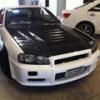GT-R Front Torque Display on IC-7
Announcements
-
Similar Content
-
Latest Posts
-
And....if that could be true for all R34 GTTs, then it might be good. But in reality it is not really any better than my standard instruction to "go out and have a look at it yourself, and wave a tape measure around" etc etc, because as soon as you have any adjustable arms, or coilovers with smaller diameter springs, or tyres that have any bulge that goes out further than the rim, etc etc, then the simple version of the information is still potentially misleading. Plus, nothing in this is static. Everything is moving. At the rear the wheels swing inward at the top as they go up, so the clearances on the inside change as the suspension is compressed. At the front it's even worse. And then you have the difference in absolute wheel position in the arch can move around more, or less, depending on how compliant the bushes are. If, like me, you have sphericals on the front caster rods (and on the FUCAs also, but these are probably less dominant when it comes to wheel position), then your wheel will swing forward/backward under loads, as well as up/down, as well as steering angle. You end up having the simple numbers with 17 caveats/footnotes for each.
-
Both windows operate normally while the engine is running but start to sag as soon as I switch off. Does anyone know of reasonably priced replacements or other brands that will fit?
-
Actually PowerFC is probably the easiest to get basic data from, it comes with a hand controller and display so you don't need to remember to pack a laptop every time you drive. It also has a PC based viewing/logging option if required. Nissan used consult on these because back in the mid 80s, ODB was just a glint in a standard's body's eyes. They switched to OBD shape around 2000 (my 2001 Cima had OBD shaped but not OBD compliant port) With the standard ECU there is a cable and software available to give basic data too, I think it is called Nissan Data Scan or s





Recommended Posts
Create an account or sign in to comment
You need to be a member in order to leave a comment
Create an account
Sign up for a new account in our community. It's easy!
Register a new accountSign in
Already have an account? Sign in here.
Sign In Now